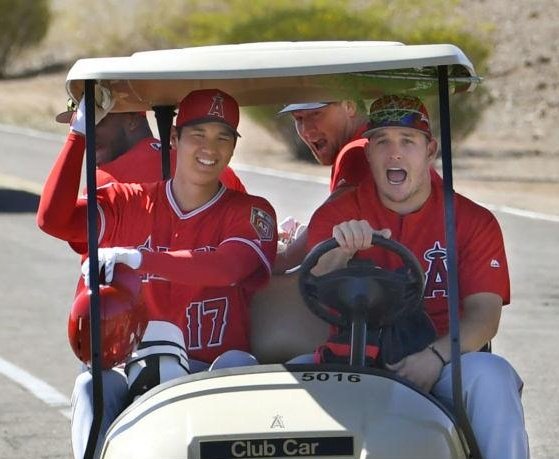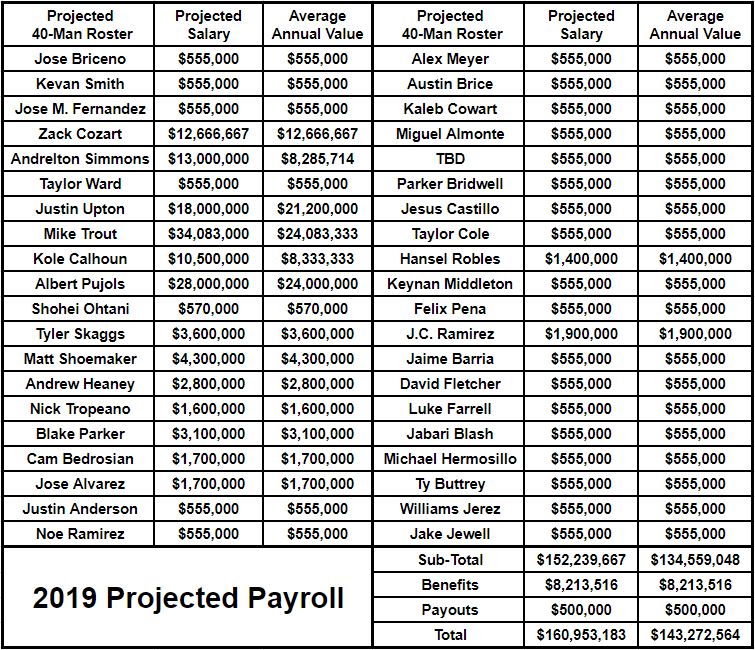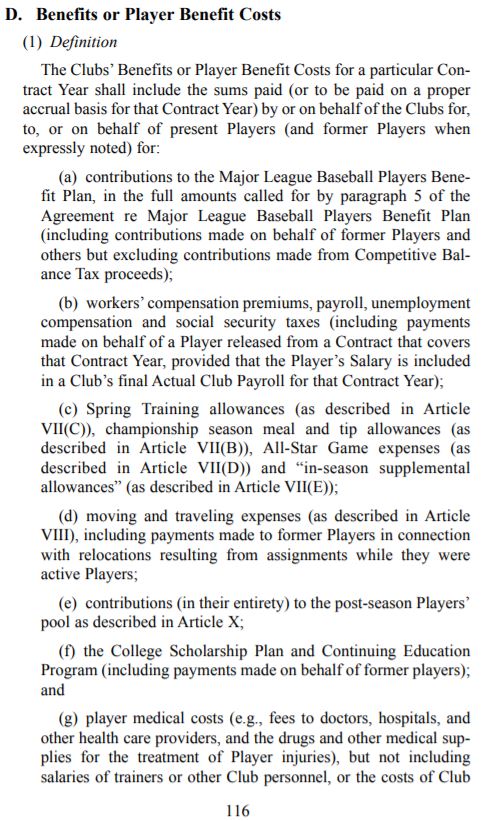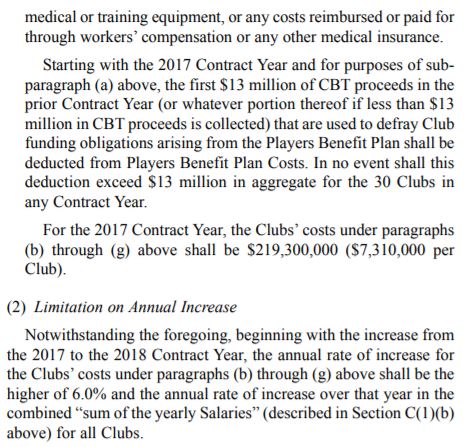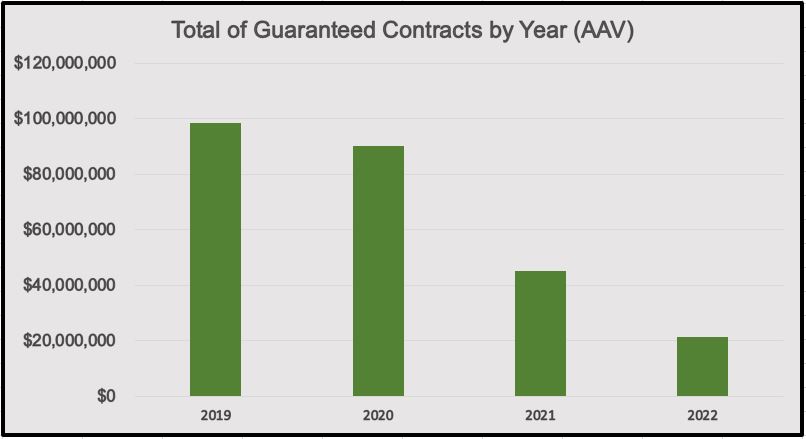By Robert Cunningham, Angelswin.com Senior Writer
Now that we have established some of the Angels primary goals, restrictions, and needs we can take a deeper dive into the teams projected finances heading into the off-season.
Below is the projected, 40-man roster, financial table that includes team benefits and all payouts (option buyouts, dead contracts, etc.) owed and is based on the assumption that the Angels bring back all of their guaranteed, contractually-controlled and current pre-arbitration and arbitration-eligible players:
Under these premises, as seen above, projected salary (actual) and Average Annual Value (AAV) will be approximately $161M and $143.3M, respectively.
Here are some notes regarding the table above:
- The roster does not consider or include any potential acquisitions, only those who are likely to stay based on the current 40-man roster at the time of publication.
- The ‘Payouts’ number has only one input, which is the $500,000 buyout of Luis Valbuena’s 2019 option.
- The arbitration numbers for Shoemaker, Skaggs, Parker, Heaney, Ramirez, Alvarez, Bedrosian, Tropeano, and Robles were obtained from MLBTradeRumors.com annual Projected Arbitration series, which is an annual snapshot of all arbitration controlled players, by team, and their projected salaries. Their system has proven to be reliably accurate over the years and the projected salaries for each of the Angels players, listed above, should not vary too widely, resulting in a negligible impact to this payroll discussion.
- It is the author’s opinion that the Angels will reward Shohei Ohtani for his superior performance by giving him a higher than normal pre-arbitration salary in the $570,000 range. This is merely speculation but it is not unprecedented in MLB history and would be warranted in Ohtani’s case.
Finally, in regard to the Finances table above, we need to discuss the ‘Benefits’ number. Here is the relevant excerpt from the MLB Collective Bargaining Agreement (CBA):
and the following page:
In last and this year’s Primer Series the author has been calculating team ‘Benefits’ using the base sum for 2017 ($219.3M above) and then adding a presumed 6%, as listed in Part (2), based on the low spending during the 2017-2018 off-season, to apply to this one.
Based on brief discussions with the OCRegister’s Jeff Fletcher on Angelswin.com and upon further review of the relevant excerpt above, it is possible that Section (1), Part (a) may contain an elusive, additional sum that should be a part of the ‘Benefits’ number listed in the Finances table at the top of the article. This sum may be close to $5M which has a marginal impact on this payroll discussion but is not a deal breaker overall. It is very probable that Jeff is correct based on discussions he has had with Major League General Managers in the past on this subject. The reader should be advised that Eppler’s ability to spend is probably less than what is advertised above based on Fletcher’s knowledge.
Moving on, the league minimum player salary for 2019 is $555,000, a $10K increase over last year, and is reflected in the Finances table, above. This, of course, applies to the pre-arbitration players except, possibly, for Shohei Ohtani. Please remember that any player not on the 25-man roster receives only Minor League pay unless their contract says otherwise. This simply means that the total payroll number, above, will be offset by about $2M-4M due to roster fluctuation throughout the 2019 season, so please keep that in mind.
As the 2018 season began, the Angels installed a new video board and offered a new series of food concessions which is a continuation of the renovations that the team committed to, as was discussed in last years Financial section of the Primer Series.
These and other upgrades were supposedly in lieu of a new stadium which may have limited significant expenditures elsewhere as the author cited in a FoxSports.com report that indicated Moreno was committed to staying in the current stadium for the next 13 years and would not opt-out.
However, Arte did, in fact, opt-out recently, setting the potential for some off-field drama if the team and the new mayor and reconstituted city council cannot arrive at an amicable agreement for the Angels to stay.
This move, by most appearances, seems to be a non-event and is probably a small-scale leverage tool to extract an additional concession or two from the city to convince Moreno to stay in Anaheim. Unless Arte has secretly negotiated a new stadium deal somewhere else, it seems to be in the best interests of both sides that the Angels stay put in Anaheim moving forward.
Ultimately, it needs to make financial sense to Arte Moreno. The city needs to avoid bad political optics, so they need to ensure that the taxpayers are not screwed and that the city receives tangible benefits in terms of employment, business, and land development opportunities. Stay tuned with the OCRegister’s Jeff Fletcher and Angelswin.com for updates on this topic moving forward.
So, based on the above, Billy Eppler should have above average payroll flexibility once the current financial year closes on December 2nd, 2018. This will allow him to target virtually any player he likes whether it is in trade or through free agency to help reinforce the 2019 Halos squad.
As was stated over the last several years, the caveat to this financial discussion is that Arte has consistently and fully funded team payroll during his time as owner so these perceived cash-related issues and thresholds may just be guidelines and could be violated at Moreno’s whim. In fact Arte did go over the Luxury Tax threshold once back in 2004, albeit, by a measly $927,000.
One potential roadblock that could curtail spending overall is actual team payroll, which is about $17M-$18M higher than AAV. If Moreno does not allow Eppler to go over a specific number, say $190M-$195M (versus the CBT threshold of $206M) in actual payroll, then Billy may not be able to fully utilize all of the Luxury Tax space available. Arte probably could authorize and handle a measured increase but by how much is anyone’s guess due to our lack of complete team financial information and insight into Moreno’s approach to spending under this current set of circumstances.
Keep in mind that one way Eppler can utilize the extra Luxury Tax payroll space is to extend one or more players (Trout being the prime target) on the roster while keeping their 2019 and 2020 actual salaries close to their current and projected numbers. For example if the Angels extend Andrelton Simmons to a 6-year, $102M deal, they can keep his 2019 salary at $13M but raise his AAV from $8.3M to $17M per season, thereby keeping actual payroll even while sponging up some of the excess AAV dollars available.
Remember, as we discussed last year, the team pulls in an annual sum of $150M from their cable deal plus an unknown amount from their partial control of the Fox Sports West Regional Sports Network (RSN) in addition to ticket and merchandise sales.
In the end Moreno completely controls how far the Angels dive in, but it seems crystal clear that Eppler has set a path that will allow Arte to choose exactly how much money is spent, how many resources are expended and where they are applied, and even how long we stay in the deep-end of the pool, which gives Moreno a great deal of leeway to get involved as much or as little as he desires.
To illustrate how Eppler has positioned the team heading into 2019, here is a snapshot of the guaranteed contractual money owed to Angels players in the coming seasons:
The Angels currently have six guaranteed contracts to pay in 2019 for Trout, Pujols, Upton, Simmons, Calhoun, and Cozart, totaling $98,569,048.
In the following year, which is Trout’s last season (currently) of contractual control, if the Angels do not hand out any more guaranteed deals before December 2nd, 2020 and they trade Kole or decline his team option, the total guaranteed money owed that season will decrease to $90,235,714. If they retain Calhoun it will rise to $104,235,714.
In the following year, which is Albert’s last season of contractual control, the total guaranteed money projects to be $45,200,000. After that only Justin Upton’s $21,200,000 remains, in the final season of his 5-year deal.
The good news here is that the Angels are in a better place financially heading into this off-season. In order to compete in 2019 they will spend more, resulting in more commitments, but the trend appears to be heading in what the author would describe as a positive direction. It will even leave room for other extensions, trade acquisitions and free agent signings.
The freedom of those decreasing guaranteed commitments leaves enough room for the Angels to extend Mike Trout this year, likely before Opening Day 2019, after the free agent market has dolled out record contracts to Manny Machado and Bryce Harper. Frankly there are virtually zero roadblocks in Eppler’s way to re-sign Trout other than Moreno’s willingness to spend which, honestly, has never been an issue and Mike’s alacrity to put pen to paper.
It should also be noted that the Angels have a few qualified players entering their 1st and 2nd years of arbitration control. This will result, dependent upon whom the Angels tender contracts to, in about $20M-25M in additional payroll for the upcoming season. It is not a huge amount for the Halos but it will have an impact on team payroll.
This arbitration situation will worsen a bit in 2020 when a lot of these players hit their 2nd and 3rd years of arbitration which will likely result in Eppler trading one or more of them away for other areas of need or perhaps not tendering a contract at all. Certain arbitration players could potentially be extended soon, as well, including Tyler Skaggs and Andrew Heaney for example, eliminating unknown arbitration numbers and adding fidelity to team payroll in succeeding seasons.
The bottom line is that Billy Eppler continues to re-tool the team year-to-year as the Angels continue to compete in the American League West. As a large market team with solid financial flexibility, a core group of competent players, and a rapidly improving farm system the team is set on a path for success despite the setbacks, performance issues, and injuries that have plagued the Halos over the last couple of seasons.
Fans should, however, temper their expectations on whom the team will acquire. As Eppler said recently, “… I’m not going to jeopardize the health of the organization to make sure I check a box.” This simply means that the Angels have set a path to sustainable success and they will not readily deviate from that path on a whim.
Also, if an opportunity to truly upgrade the 2019 team materializes, Moreno may extend the financial rope a modest amount if it involved his proverbial “… right player, in the right situation…”. Again this type of player is unlikely to be acquired by the Angels this off-season. However, if they hit the Trade Deadline and have the opportunity to add one or two finishing pieces to push all-in to make the playoffs, Arte could put his blessing on pushing past the artificial CBT threshold and trading away one or two quality prospects to give a solid nudge to a playoff-caliber squad. A “Big Splash”, as seen in the movie Draft Day, should not be expected in the months leading up to Opening Day 2019.
Based on this outlook the Angels are likely to start the year by staying within their means, remaining under the 2019 CBT threshold of $206M (AAV) with an actual team payroll of about $190M-195M, give or take.
Finally, if the Angels are able to extend Mike Trout this off-season (or next) every Angels fan should rejoice. That, by itself, would be the crown jewel of an exciting off-season.
In the next section we will discuss team Production.
Add The Sports Daily to your Google News Feed!

